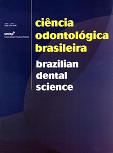Avaliação clínica e microbiana da terapia periodontal mecânica em indivíduos com
DOI:
https://doi.org/10.14295/bds.2004.v7i1.410Abstract
O objetivo deste estudo foi avaliar o comportamento clínico de bolsas periodontais ≥ 6 mm de profundidade em indivíduos com periodontite crônica após tratamento com raspagem e aplainamento radicular (RAR) e a presença de periodontopatógenos. Foram incluídos 35 indivíduos, de ambos os gêneros, com idade entre 26 e 60 anos (40,7 ± 9,1) previamente diagnosticados com periodontite crônica. Foram selecionados quatro sítios com profundidade de sondagem (PS) ≥ 6 mm em cada indivíduo, totalizando 140 sítios avaliados. Os sítios selecionados foram submetidos aos procedimentos de RAR realizados por um único operador e por um período de tempo padronizado. A mensuração da PS foi realizada no momento inicial e após 90 dias. Através de PCR avaliou-se a presença de A. actinomycetemcomitans, P. gingivalis, P. intermedia, B. forsythus, C. rectus, E. corrodens, F. nucleatum subsp. nucleatum e F. nucleatum subsp. vincentii no momento inicial e após 120 dias. O produto amplificado por PCR (rDNA 16S) foi analisado por ensaio Dot-Blot. Os resultados foram submetidos a tratamento estatístico através dos testes Wilcoxon para PS e Kruskal-Wallis e T-Student para presença de periodontopatógenos. Observou-se redução na PS (p<0,05) quando se comparou PS inicial e após 90 dias. Em relação aos periodontopatógenos examinados, observou-se redução (p<0,05) entre os dois tempos analisados, exceto para C. rectus, E. corrodens e F. nucleatum subsp. nucleatum independentemente do gênero. Assim, concluiu-se que as bolsas periodontais analisadas apresentaram uma resposta clínica e microbiana compatível com a proposta da terapia mecânica periodontal, podendo ser indicada nos indivíduos com periodontite crônica.
Downloads
Downloads
Published
How to Cite
Issue
Section
License
Brazilian Dental Science uses the Creative Commons (CC-BY 4.0) license, thus preserving the integrity of articles in an open access environment. The journal allows the author to retain publishing rights without restrictions.
=================




























